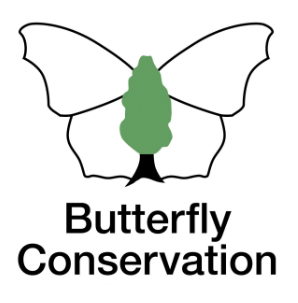Brown Argus
Brown Hairstreak
Chalkhill Blue
Clouded Yellow
Comma
Common Blue
Dark Green Fritillary
Dingy Skipper
Essex Skipper
Gatekeeper
Green Hairstreak
Green-veined White
Grizzled Skipper
Holly Blue
Large Skipper
Large White
Marbled White
Meadow Brown
Orange-tip
Painted Lady
Peacock
Purple Emperor
Purple Hairstreak
Red Admiral
Ringlet
Silver-washed Fritillary
Small Blue
Small Copper
Small Heath
Small Skipper
Small Tortoiseshell
Small White
Speckled Wood
Wall
White Admiral
White-letter Hairstreak
Extinct/rare immigrants
Essex Skipper
Thymelicus lineola
General Distribution and Status
The Essex Skipper is widespread and common south of the line between Dorset and north Lincolnshire but numbers have markedly decreased since 1976 (Fox et al.). It was expanding northwards and westwards although it appears no longer to be significantly doing so. In Hertfordshire and Middlesex, the drop in numbers seems to be even higher than that of the Small Skipper especially since the turn of the century although perhaps the abundance figures should not be read into too much due to the difficulty in identifying this species compared to the Small Skipper. There appears to be some pick up in numbers since 2022. In the 1990s the Essex Skipper was more common than its closest relative (Murray & Wood). Because females emerge with immature eggs, nectar sources are very important for food to increase their reproductive potential (Field et al.).
| United Kingdom | Herts & Middx | |||
| Distribution | 1976-2019 | +82% | 1980-2015 | -48% |
| Average 10-year trend | +14% | 2006-2015 | +26% | |
| 2024 since 2015-19 | -6% | |||
| Abundance | 1976-2024 | -27% | 1980-2015 | -58% |
| 2015-2024 | -30% | 2006-2015 | -74% | |
| 2023-2024 | -46% | 2024 since 2015-19 | +20% | |
UK distribution map
UKBMS Species summary
Habitat Requirements
Tall uncut grassland in places similar to the Small Skipper.
Larval Foodplants
Cocks-foot Dactylis glomerata and Creeping Soft-Grass Holcus mollis. Timothy Phleum pratense, False Brome Brachypodium sylvaticum and Tor Grass B. pinnatum are also sometimes used (Sawford).
Adult Food Sources
Cow Parsley Anthriscus sylvestris (12), Thistles Cirsium sp. (8).
Historical Records
No mention of the species was included in Gibbs' 1902 report but the butterfly existed in the county in the Bishop's Stortford area in 1885-88 (Sawford) which pre-dates the year when it was added to the British List in 1889. As the 20th century wore on, more sightings were made especially from the 1940s onwards by which time it was more abundant than the Small Skipper in some places like Walkern (Foster). Rev. Greenham from Walkern, who caught several specimens in local fields in around 1941, referred the species as a Scarce Small Skipper (Birdsall). The first record for the Norton Green and Knebworth Woods area was a single specimen seen by myself at Norton Green on 25 July 1979 and many were spotted there by Sawford on 26 July 1983 but there were no reports submitted from Palmer and Ferry in the 1920s and 1940s respectively. The Essex Skipper was probably more under-recorded in the early years of the last century.
Local Distribution and Abundance
The butterfly is widely distributed in the Stevenage area with just one tetrad(TL22X) not containing records since 1995. This is surprising because there is some rough grassland south of Walkern towards Benington which looks suitable for this species. In the 2010-2019 decade there are reports from only 13 tetrads as shown on the map. What is not evident from the map is that numbers have fallen dramatically which is a reflection on the declining state of the species in the region as a whole. Although the species inhabits the same places as the Small Skipper, it appears at Symonds Green where the latter is seemingly absent. 2025 was the worst year on record with only three reports, all in the Knebworth area.

Stevenage (South Fairlands Valley) transect 1993-2025
Although there was a significant decline since the middle of the last decade as was the case elsewhere there was a huge increase in 2015 with a count of 90 which turned out to be the best year. The change in the cutting regime on grassy areas like Shackledell Grassland where virtually all these butterflies were found was probably a major contributory factor. There was a big cut at the site during the winter of 2014-15, the first for several years, with just a few pockets of tall vegetation left alone. Perhaps the site provided the perfect conditions for a good mix of grasses and flowers, shelter and warmth. However, since then, numbers have fallen dramatically once again. The majority of golden skippers were not identified so the transect abundance chart includes a plot for estimated numbers of this species.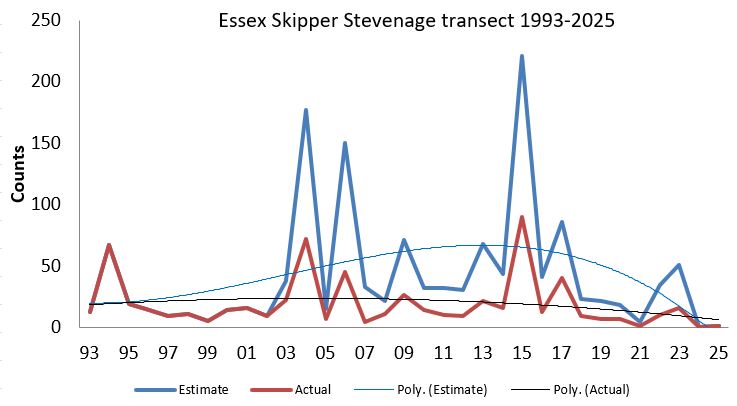
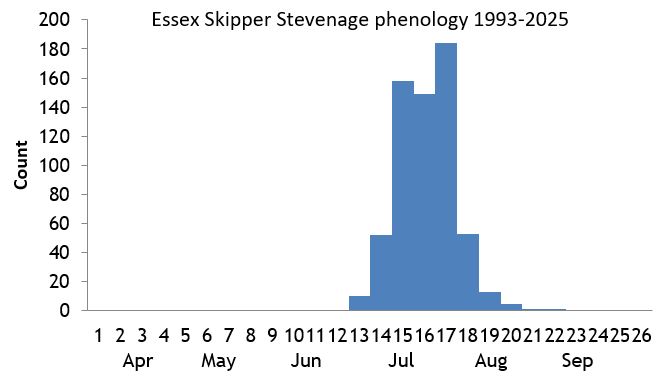
Knebworth Park transect 1996-2010 and 2017-2025
There has been a dramatic drop in numbers for this species since 2005 when 977 were counted. Only nine were recorded in 2010, only eight in 2020 to 2022 inclusive but a huge pick-up in 2023 to 16. Reasons for the fluctuating fortunes are unknown but habitat change is probably a contributory factor - see above. Since 2019, grazing by deer in the park itself and inclement spring weather leading to fewer tall tussocks of grass are possible causes during the 2020 to 2022 period. Only three adults were seen in 2024 probably due to the wet and cool weather earlier in the year impacting larval development but none were noted in 2025.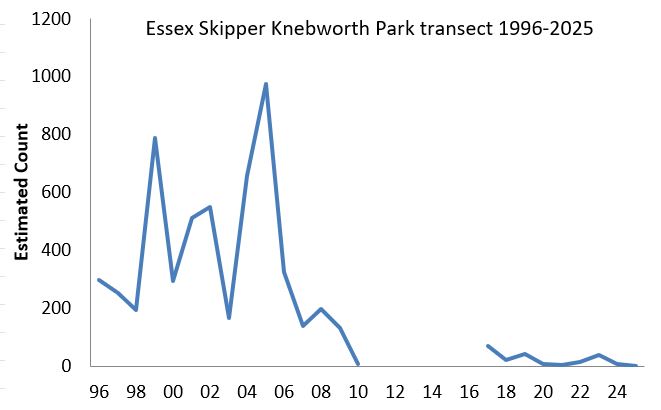
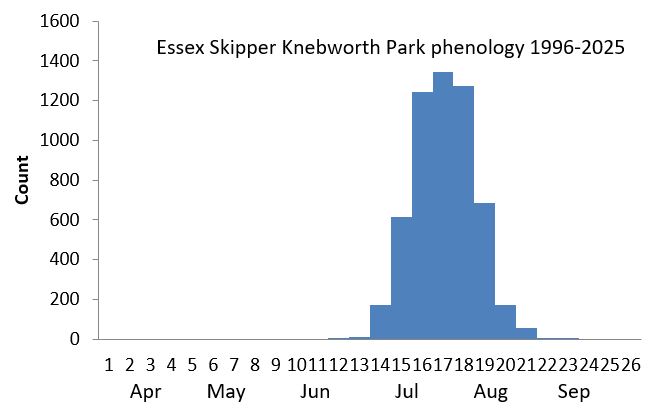
Knebworth Woods transect 2017-2025
This species is rarely seen here with the best year in 2017, when five were recorded of which two were positively identified in Burleigh Meadow and three at Norton Green Common. Estimated numbers are too low to determine any trend.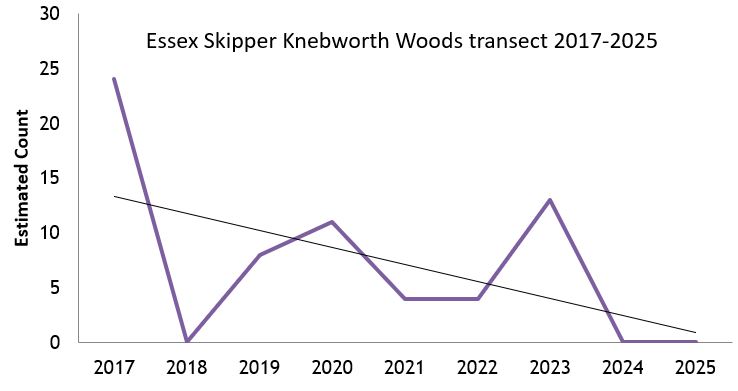
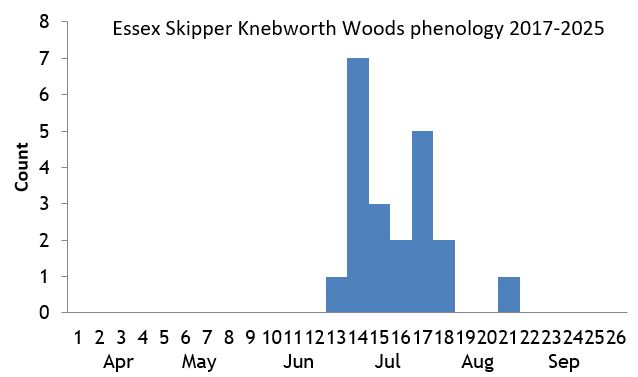
Pryor's Wood transect 2000-2022
This species was reported in only 2006, 2007 and 2013 with four counted on 8 July 2007 and 21 July 2013. One skipper seen in 2017 could not be positively identified.Life History
Earliest date: 17 June 2017 at Knebworth Park
Latest date: 4 September 1996 at Knebworth Park
This species is on the wing in July and
August with a peak in the last week of July so there is some significant overlap with the Small Skipper although its flight season generally begins about
two weeks later. Eggs are laid on the sheaths of grasses and hatching does not occur until the following spring when the larvae feed within tubes spun
from the leaf blades. A cocoon is formed among the vegetation for pupation to take place.
Behaviour/Observation notes
As noted for the Small Skipper, cloudy weather, early morning or evening when the skippers are most likely to be at rest, are the times to distinguish between the two species. If either species is a male, then the nature of the sex brand on the forewing determines the species it relates to. A straight narrow line parallel to the edge of the forewing is suggestive of an Essex Skipper whereas a more crooked line indicates a Small Skipper. However, this distinguishing feature is probably not as reliable as the undersides of the antennae. If they are jet-black, the butterfly is an Essex Skipper otherwise if it is more orange-brown it is a Small Skipper.
Variations/Aberrations
Varieties or aberrations of the Essex Skipper are very rare or unknown.
Find out more on the UK Butterflies website
References
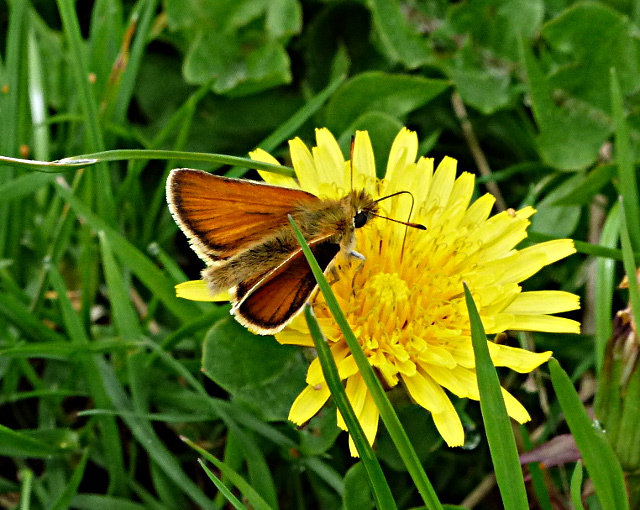
Shackledell 15 Jul 2016 (m)
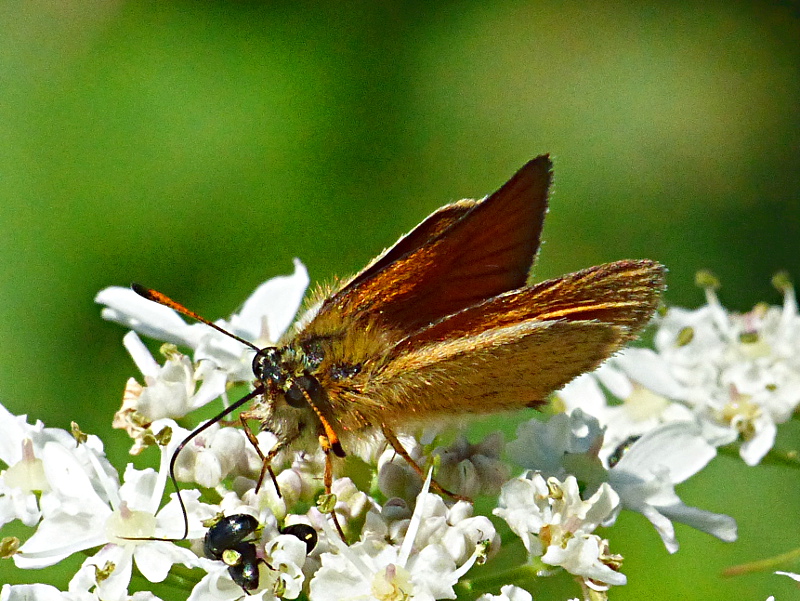
Norton Green 3 Jul 2019
